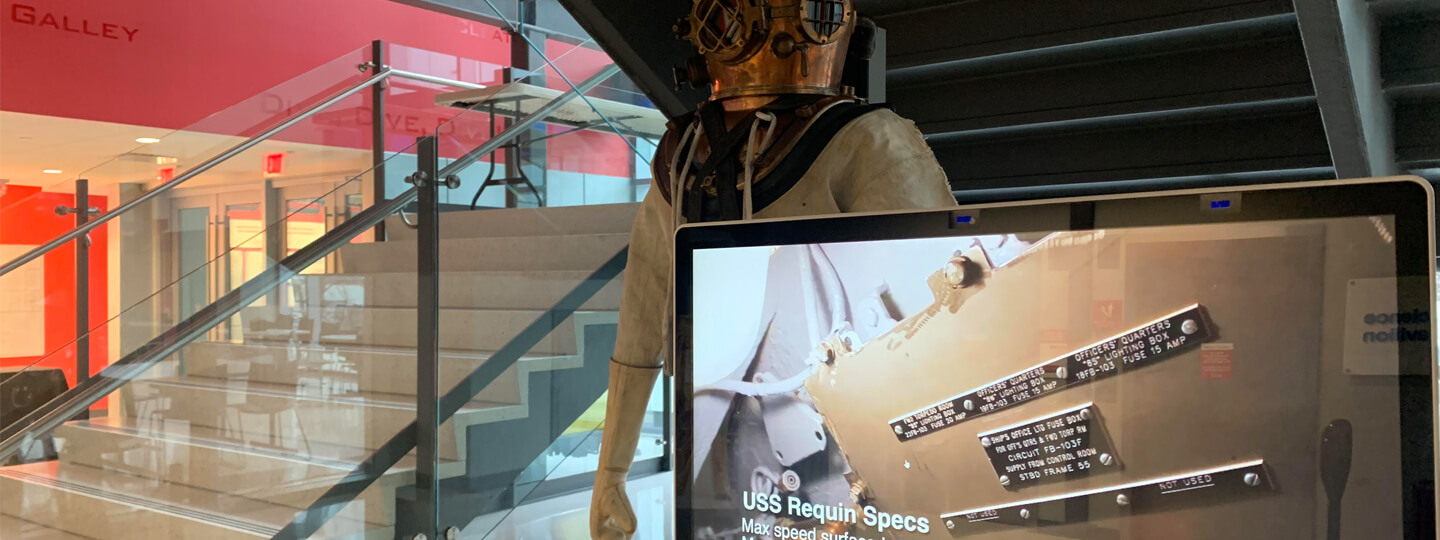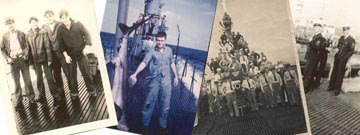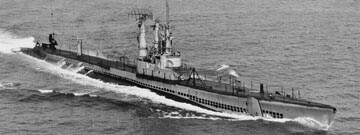
USS Requin Gateway
Come aboard a new way to explore USS Requin (SS 481)! Located in the Science Center’s grand staircase and Grable Riverside Lobby, USS Requin Gateway enhances the on-board experience for those guests who tour the submarine, while providing a way for guests unable to go below deck to see and explore the boat.
USS Requin Gateway is perfect for all ages, especially visitors interested in military history and technology, engineering, and the Cold War era. While Requin is a Cold War-era submarine, visitors interested in World War II will also enjoy these exhibits.
Many of these new exhibits provide access to submarine-based content for those unable to board the ship.
Exhibits include:
- United States Navy Mark V Dive Suit, circa 1950 – The Mark V diving rig, invented in 1916 and used until 1984, allowed divers to work at previously unreachable depths. The pressurized suit is made from cotton canvas over rubber, with watertight seals for the brass helmet, gloves, and weighted boots. Divers wore woolen bodysuits beneath the main rig for warmth, and weighted belts to assist in buoyancy and resurfacing. The technology of the Mark V was instrumental in developing high altitude flight suits and early space suits.
- Mark 9 Mod 3 Depth Charge – A depth charge is an anti-submarine weapon, essentially a bomb dropped from surface ships or aircraft. The device can be set to detonate at a certain depth, subjecting the target to explosive shockwaves. The Mark 9 was a significant advancement in depth charge engineering, modifying the existing barrel shape to a weighted teardrop and adding fins, allowing it to travel faster and on a more direct trajectory. The Mod 3 design was used from late in WWII through the Cold War.
- Torpedo – The Mark 14 was the standard anti-ship torpedo used by the submarine service during World War II. Over 13,000 were produced and remained in use on submarines until 1980.
- Scale Model: USS H-1 (SS-28)
Commissioned: 1913
Length: 150’4”
Beam (Width): 15'10"
Crew: 25
Maximum Depth: 200'
Power: Diesel ElectricUSS H-1 was originally named USS Seawolf, the first submarine to hold the name. H-1 patrolled the west coast of the United States from 1913 until the outbreak of WWI in 1917, when the submarine was transferred to the east coast. The submarine guarded waters off the coast of the important seaports in New England and served as an education vessel for new submariners until 1920, when it ran aground while on route back to the west coast.
- Scale Model: USS Pittsburgh (SSN-720)
Commissioned: November 23, 1985
Decommissioned: Scheduled 2020
Length: 361’ 11”
Weight: 5,895 tons surfaced / 6,292 tons submerged
Crew: 110USS Pittsburgh (SSN-720) is a Los Angeles class nuclear powered, fast attack submarine. Los Angeles class submarines are considered the backbone of the US Navy submarine force and have more submarines than any other class in the world. USS Pittsburgh carries the nickname “Heart of Steel” after her namesake city.
Artifacts and Personal Memorabilia – U.S. Navy signal gun, original piece of USS Requin’s white ash deck, USS Requin’s ward room ashtray, submarine insignia, pennant, emergency lantern, Lionel Corporation telegraph key, quartermaster’s spyglass, and more.
- Video Tour – Watch an on-board video that takes you through the passageways and compartments of this engineering marvel.
- Virtual Periscope – Explore a 360-degree view of the Pittsburgh skyline in daylight and at night, from the perspective of the periscope mounted high above Requin’s decks.
- Digital Scrap Book – Flip through digitized photos of Requin’s service and crew, as well as blueprints and news stories from her history at sea.
- Engines 101 – Animated interactives allow you to explore the engineering marvel that propelled a diesel submarine over – and under – the High Seas.
USS Requin Gateway
Come aboard a new way to explore USS Requin (SS 481)! Located in the Science Center’s grand staircase and Grable Riverside Lobby, USS Requin Gateway enhances the on-board experience for those guests who tour the submarine, while providing a way for guests unable to go below deck to see and explore the boat.
USS Requin Gateway is perfect for all ages, especially visitors interested in military history and technology, engineering, and the Cold War era. While Requin is a Cold War-era submarine, visitors interested in World War II will also enjoy these exhibits.
Many of these new exhibits provide access to submarine-based content for those unable to board the ship.
Exhibits include:
- United States Navy Mark V Dive Suit, circa 1950 – The Mark V diving rig, invented in 1916 and used until 1984, allowed divers to work at previously unreachable depths. The pressurized suit is made from cotton canvas over rubber, with watertight seals for the brass helmet, gloves, and weighted boots. Divers wore woolen bodysuits beneath the main rig for warmth, and weighted belts to assist in buoyancy and resurfacing. The technology of the Mark V was instrumental in developing high altitude flight suits and early space suits.
- Mark 9 Mod 3 Depth Charge – A depth charge is an anti-submarine weapon, essentially a bomb dropped from surface ships or aircraft. The device can be set to detonate at a certain depth, subjecting the target to explosive shockwaves. The Mark 9 was a significant advancement in depth charge engineering, modifying the existing barrel shape to a weighted teardrop and adding fins, allowing it to travel faster and on a more direct trajectory. The Mod 3 design was used from late in WWII through the Cold War.
- Torpedo – The Mark 14 was the standard anti-ship torpedo used by the submarine service during World War II. Over 13,000 were produced and remained in use on submarines until 1980.
- Scale Model: USS H-1 (SS-28)
Commissioned: 1913
Length: 150’4”
Beam (Width): 15'10"
Crew: 25
Maximum Depth: 200'
Power: Diesel ElectricUSS H-1 was originally named USS Seawolf, the first submarine to hold the name. H-1 patrolled the west coast of the United States from 1913 until the outbreak of WWI in 1917, when the submarine was transferred to the east coast. The submarine guarded waters off the coast of the important seaports in New England and served as an education vessel for new submariners until 1920, when it ran aground while on route back to the west coast.
- Scale Model: USS Pittsburgh (SSN-720)
Commissioned: November 23, 1985
Decommissioned: Scheduled 2020
Length: 361’ 11”
Weight: 5,895 tons surfaced / 6,292 tons submerged
Crew: 110USS Pittsburgh (SSN-720) is a Los Angeles class nuclear powered, fast attack submarine. Los Angeles class submarines are considered the backbone of the US Navy submarine force and have more submarines than any other class in the world. USS Pittsburgh carries the nickname “Heart of Steel” after her namesake city.
Artifacts and Personal Memorabilia – U.S. Navy signal gun, original piece of USS Requin’s white ash deck, USS Requin’s ward room ashtray, submarine insignia, pennant, emergency lantern, Lionel Corporation telegraph key, quartermaster’s spyglass, and more.
- Video Tour – Watch an on-board video that takes you through the passageways and compartments of this engineering marvel.
- Virtual Periscope – Explore a 360-degree view of the Pittsburgh skyline in daylight and at night, from the perspective of the periscope mounted high above Requin’s decks.
- Digital Scrap Book – Flip through digitized photos of Requin’s service and crew, as well as blueprints and news stories from her history at sea.
- Engines 101 – Animated interactives allow you to explore the engineering marvel that propelled a diesel submarine over – and under – the High Seas.



